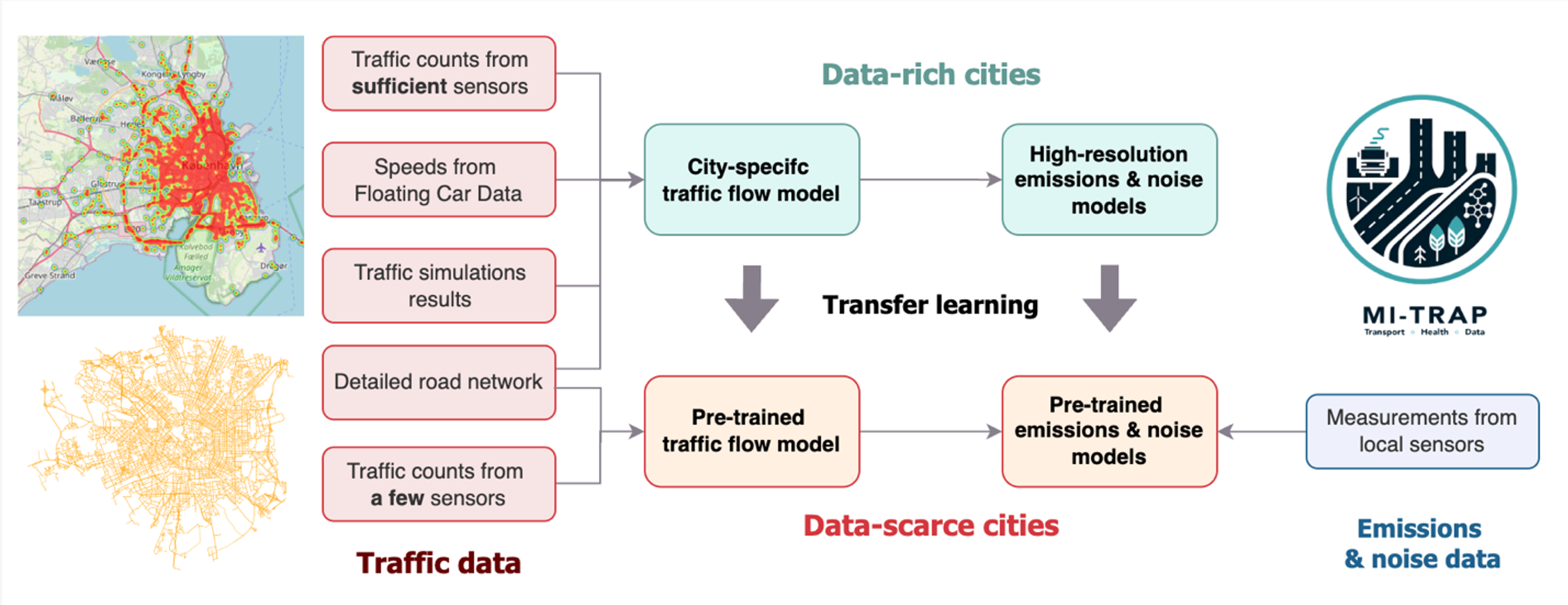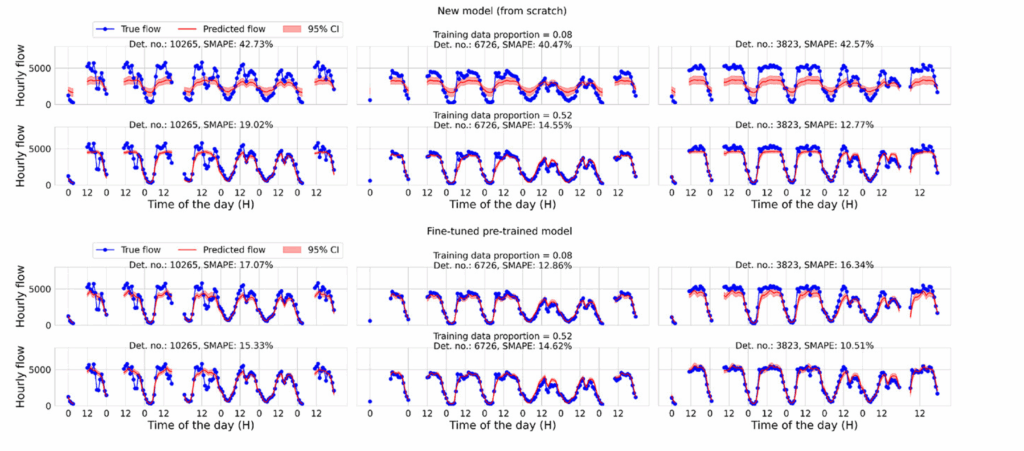17 Jun Blog | How MI-TRAP is using AI to model traffic, air pollution and noise levels in the pilot cities
by Laura Gualda, Ramandeep Singh and Constantinos Antoniou (TUM)

Have you ever walked past a busy road with apartment buildings on both sides and wondered how the people living in these buildings cope with the constant noise and air pollution? If not, take a moment to think about it: traffic does not just cause delays in our daily trips, it harms our health and the planet with its contributions to the not-so-invisible layers of emissions and noise.
In the public health research community, air pollution has been called a ‘silent epidemic’ (Schraufnagel, 2020), and for a good reason. Unlike a traditional disease outbreak, pollution’s health impacts unfold quietly over the years, contributing to premature deaths and chronic illnesses, as explored in MI-TRAP’s previous blog post. In terms of the climate crisis, some facts give us reasons for cautious optimism. While transport as an economic activity accounted for nearly a third of the EU’s total greenhouse emissions, road transport has been reducing the emissions of most traditional pollutants since 1990. At the same time, the portion of non-exhaust emissions (e.g. from brake and tyre wear) of PM2.5 and PM10 has been increasing in importance (EEA, 2024).
In the MI-TRAP project, we are aware that the challenge extends beyond the pollutants we usually hear about. We also believe that every high-traffic street deserves attention to becoming safer and healthier. However, the question remains: how can we monitor traffic-related air and noise pollution across entire cities when most of them have no more than a few scattered sensors dedicated to the task? As transportation researchers at the Technical University of Munich (TUM), we are developing artificial intelligence (AI) models, specifically neural networks, using data from cities with comprehensive traffic and air quality monitoring. Our goal is to extract fundamental traffic patterns that can be extrapolated to the ten MI-TRAP pilot cities to provide near real-time estimates of traffic, as well as air and noise pollution at the city scale.
Traffic prediction challenges: From data scarcity to spatio-temporal complexities
Two key aspects must be considered when using neural networks to predict traffic at the city scale: selecting a model architecture capable of capturing the complexities of the task at hand and having sufficient and representative data to train an accurate model.
Choosing the right model in our case means being able to mathematically represent the full complexity of the urban road traffic system. Spatially, traffic flow and congestion patterns on one street influence connected streets and entire neighborhoods through route choice behavior and network effects. Simultaneously, temporal aspects affect traffic in multiple ways: think about commuting peak hours, the traffic variations on weekends, holidays and special events, and how the season and weather affect drivers’ decisions. To be able to capture and represent all these patterns, we rely on a special class of neural networks, namely Graph Neural Networks (GNN). This class of models is particularly effective at capturing spatial relationships by representing road networks as graphs, where intersections are represented as nodes and road segments as edges, allowing the model to learn how traffic propagates throughout entire cities.
The data availability challenge varies greatly from city to city. Traditionally, training models like GNNs require plenty of high-quality traffic data from the city itself. But collecting detailed traffic data on all major streets across entire cities using traditional sensors is expensive and hard to scale, even for wealthy cities. This lack of data poses a fundamental problem for modelling traffic and its related emissions: without the ability to predict traffic peak times and locations, it is difficult to understand how pollution hotspots form and change over time.
Among the 10 MI-TRAP pilot cities, some collect and publicly provide a substantial amount of traffic data, while others do not. For example, while Copenhagen and Lisbon make past traffic data accessible, Berlin and Milan do not publish this information on their open portals. Therefore, to build reliable models for all the pilot cities, we must come up with some alternatives. In our case, these are: 1) using emerging data sources, such as GPS data from probe vehicles, to indirectly estimate traffic, and 2) leveraging transfer learning, which we will explore in the next section.
Transfer Learning to the Rescue: Leveraging data from data-rich cities
One of the biggest challenges in MI-TRAP is the uneven availability of traffic data across all 10 pilot cities. To address this, we are applying transfer learning, a machine learning approach that is particularly suited for dealing with data scarcity scenarios. In simple terms, transfer learning involves training a model in one or more data-rich environments and then adapting it to perform in settings with limited or no data.
A recent study from our research group at TUM (Mahajan et al., 2023) demonstrated how this approach can predict traffic within and across cities. The study proposes a framework based on transfer learning and Long Short-Term Memory (LSTM) neural networks to first learn traffic patterns on data-rich cities and apply the learned model in cities with limited data. As a case study, they pre-trained a model using Paris public traffic data and applied it to predict traffic in Madrid, a city with significantly less publicly available data. The results showed that, for predictions in the target city (Madrid), models trained using data from the data-rich Paris can outperform models trained using Madrid’s limited data. The accuracy improvements are more substantial when the transferred model has sufficient city-specific knowledge to assimilate from the target domain.

Figure from Mahajan et al. (2023): Flow predictions on test data in Madrid (target domain) using a new model (city-specific) and fine-tuned pre-trained (Paris) model. Both models are tested using different proportions of training data.
Of course, not all cities are alike and transferring models across them is not that simple. Traffic patterns are influenced by city-specific factors including urban layout, public transportation availability, economic activity patterns, and cultural driving behaviors. A model trained on Copenhagen data might struggle in Milan unless these differences are accounted for. Our focus is on building these models not only transferable, but also adaptable, so they can learn from one city, while adjusting to the specifics of another.
With the appropriate transfer learning approach, we can develop adaptable models for traffic, air and noise pollution – even in cities with limited data or resources. These models will provide results for an important component of the MI-TRAP Toolbox, which will enable near real-time monitoring of predicted city-wide traffic flow, emissions, and noise levels.
Looking ahead: The MI-TRAP toolbox for monitoring traffic-related air quality and noise levels
You might be wondering: Okay, that is an interesting research workflow, but how does it lead to actionable insights for cities in the real world? That is where the MI-TRAP Toolbox comes in. Stay tuned to learn more about the platform we are developing to bring this and other insights from all corners of the project to life.
About
Laura Gualda is a Doctoral Researcher, Ramandeep Singh is a Postdoctoral Researcher and Constantinos Antoniou is the full professor in charge of the Chair of Transportation Systems Engineering at the Technical University of Munich (TUM).
References
European Environment Agency (EEA). (2024). Emissions of air pollutants from transport. https://www.eea.europa.eu/en/analysis/indicators/emissions-of-air-pollutants-from. Accessed in May 2025.
Mahajan, V., Cantelmo, G., Rothfeld, R., & Antoniou, C. (2023). Predicting network flows from speeds using open data and transfer learning. IET Intelligent Transport Systems, 17(4), 804-824. https://doi.org/10.1049/itr2.12305
Schraufnagel, D. E. (2020). The health effects of ultrafine particles. Experimental & Molecular Medicine, 52(3), 311-317. https://doi.org/10.1038/s12276-020-0403-3


